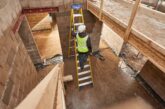
 Essential equipment or safety hazard? Francis Camilleri, Technical Director at T.B. Davies, and Chair of the Ladder Association Technical Committee, gets to the truth about telescopic ladders
Essential equipment or safety hazard? Francis Camilleri, Technical Director at T.B. Davies, and Chair of the Ladder Association Technical Committee, gets to the truth about telescopic ladders
Telescopic ladders have become an indispensable part of the construction professional’s toolkit. Their portability, compact design, and adjustable height make them ideal for navigating tight spaces and tackling diverse tasks. Yet, alongside their rising popularity comes a pressing safety concern: an alarming number of telescopic ladders on the market fail to meet basic safety standards, putting builders at significant risk.
The Ladder Association’s latest safety report highlights the scale of the problem, revealing that over 80% of telescopic ladders tested failed critical safety assessments. Many of these ladders were falsely advertised as compliant with the European standard EN 131, misleading buyers into believing they were purchasing safe and reliable products. This highlights the urgent need for construction professionals to make informed choices about the equipment they rely on for their work.
This article examines how to identify safe, compliant telescopic ladders, offers practical advice on safe use and maintenance, and explains why these tools remain essential parts of your toolkit despite the challenges posed by unsafe products.
How to identify safe, compliant ladders
Understanding safety standards is key to choosing the right telescopic ladder. The EN 131-6 standard is the benchmark for compliance, indicating that a ladder has undergone stringent testing for safety and durability. Always check for EN 131 certification marks on the ladder itself and in the accompanying documentation.
A compliant ladder incorporates specific design features that enhance stability and user safety. For example, ladders over three meters must include a wide base to reduce the risk of tipping. High-quality, compliant ladders will use robust locking systems that engage all rungs simultaneously. Avoid ladders with individual rung locks, as they can result in uneven rung spacing—a significant trip hazard.
Beware of suspiciously low-priced ladders or products displaying misleading safety markings like CE or UKCA, which are not valid ladder certifications. To minimise risk, purchase only from reputable suppliers, ideally members of the Ladder Association. These suppliers adhere to strict quality and safety standards, ensuring you receive a compliant product. A directory of trusted sellers is available on the Ladder Association website.
Maintaining and using telescopic ladders safely
Even the best ladder requires proper care and handling to ensure its continued safety and performance. Before each use, inspect the ladder for signs of wear or damage, such as cracked stiles, worn feet, or malfunctioning locking mechanisms. Telescopic ladders, in particular, have multiple moving parts that require attention. Ensure all components are clean and debris-free to prevent jamming or malfunction.
Store your ladder in a dry, clean environment to protect it from corrosion or damage. To prevent structural harm, avoid stacking heavy items on top of the ladder during transport. Dirt and grit can jam the telescopic mechanism, so clean and lubricate the ladder with a silicone-based polish if needed before storage.
Always set up the ladder on a stable, level surface. For optimal stability, position it at a 70 to 75-degree angle. Ensure all locking mechanisms are fully engaged before climbing, and maintain three points of contact – such as two hands and one foot – while working at height.
Common errors, such as overreaching or improper positioning, are frequent causes of accidents. Extend the ladder to the correct height for the task and remain centred between the stiles to avoid tipping.
Why telescopic ladders are vital
Despite the challenges posed by substandard products, telescopic ladders remain indispensable for construction professionals. Their portability and adjustable height make them perfect for a variety of tasks, from inspections to finishing touches on hard-to-reach areas.
High-quality telescopic ladders undergo rigorous testing to meet the demands of professional use. For example, reputable brands test their locking mechanisms through 4,000 open-and-close cycles. Compliant telescopic ladders must hold a quarter of a tonne of weight during testing, providing a safety margin that supports their professional rating of 150 kilograms.
These tests ensure compliant telescopic ladders are as reliable and durable as traditional ladders, dispelling the misconception that they are inherently less safe.
Pushing for change
The influx of unsafe ladders, particularly from unregulated online marketplaces, is deeply concerning. Third-party sellers are not required to verify product safety, leaving construction professionals at risk of purchasing dangerous tools.
The Ladder Association is actively campaigning for stricter regulations and greater accountability among online platforms. The organisation also offers educational resources, including guidance documents and training programs, to help professionals make safer choices and adopt best practices.
Construction professionals can play their part by prioritising safety in both purchasing and daily use. Choosing certified ladders, maintaining them properly, and following correct usage protocols will help mitigate risks and ensure these versatile tools serve you reliably for years to come.
For further advice on ladder safety or a list of reputable suppliers visit the Ladder Association website: Home – The Ladder Association.
If you would like to view the latest Ladder Association Telescopic Ladder Report visit: Latest Telescopic Ladder Research Report Launched – The Ladder Association.
Francis Camilleri is the Technical Director at T.B. Davies, a leading provider of safe access solutions and Chair of the Ladder Association Technical Committee. He is also a member of the British Standards Institute (BSI) B512 Committee. For more information, visit Professional Work at Height Solutions for Industry – TB Davies™.







